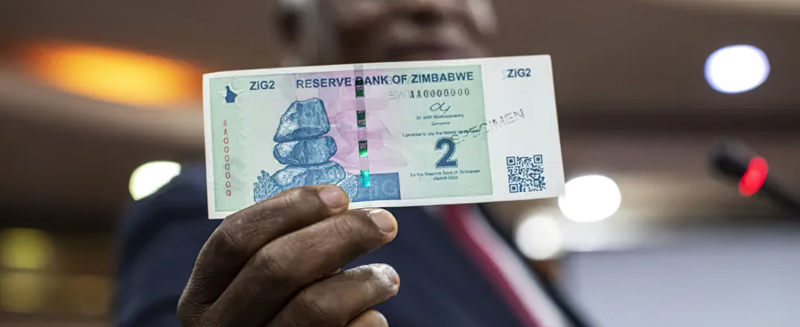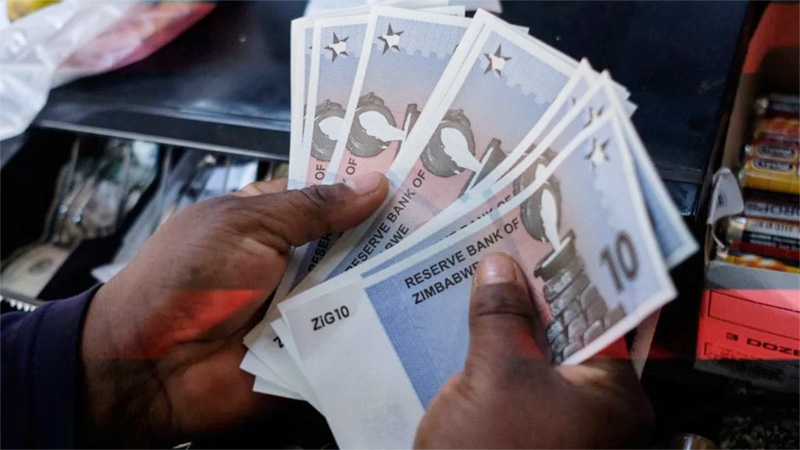- Introduction of Zimbabwe Gold (ZiG) bank notes.
- Limitations on purchasing fuel, gas, or conducting international trade.
- Collaboration with World Bank experts by the Reserve Bank of Zimbabwe for currency development.

Zimbabwe has introduced its sixth currency since gaining independence in 1980, called Zimbabwe Gold (ZiG). This new money just started circulating this week, as the government tries once again to control inflation.
You can now find coins for 1, 2, and 5 ZiG, and there are also notes available in denominations ranging from ZiG10 to ZiG200.
President Emmerson Mnangagwa seems happy with how people are reacting to ZiG since its launch.
“I commend all Zimbabweans for the manner in which we have adopted and are protecting the use of our currency,” he said.
The ZiG, as per the government, is supported by 2.5 tonnes of gold and other valuable minerals like diamonds. This backing makes it what they call a “structured currency.”
John Mushayavanhu, the Reserve Bank of Zimbabwe (RBZ) governor, mentioned in a media statement that ZiG came about after extensive consultations with experts from the World Bank.
The governor promised that unlike past practices, where money was printed excessively without care, such actions wouldn’t be allowed during his tenure.
Pay more if you pay in ZiG
ZiG is now accessible in banks across the country, with specific withdrawal limits set. Individuals can withdraw up to ZiG3,000 (about R5,460) per week.
Corporates have a weekly limit of ZiG30,000 (R54,560), while schools, hospitals, clinics, and local authorities can access ZiG250,000 (R455,000) per month. Government departments are allowed ZiG300,000 (R545,600) monthly.
In Bulawayo, the second-largest city, vendors are hopeful that ZiG could provide a temporary solution to their financial challenges.

Sandra Moyo said:
I don’t mind selling my vegetables in the ZiG, provided I won’t have issues when restocking. But for those who import goods the stability of the ZiG will make it work provided they find an official source to buy forex to restock in say, South Africa and Botswana.
Officially, the rand to ZiG exchange rate in Zimbabwe shows ZiG in a stronger position. However, within just a month of its digital introduction, ZiG has already lost value on the black market.
“We do simply sell our things more expensive in the ZiG so that we have room to buy the costly forex on the streets. In some cases, this discourages people from buying using the ZiG when they have forex, which is more competitive,”
Moyo said.
“Therefore, as long as the ZiG does not earn the bad money tag, we are ready to trade.”
Local public transport operators have not yet started accepting ZiG.
Taruvinga Zhou, a transport operator, explained, “Our challenge is that we buy fuel in foreign currency. We are used to setting fares in rands and American dollars. Right now, we don’t have a ZiG fare.”
Only Air Zimbabwe and Fast Jet currently accept ZiG payments.
Back in 2022, Zimbabwe owed international airlines like South African Airways (SAA) and Emirates a total of $177.6 million. This money couldn’t be repatriated due to currency shortages.
Economists believe these airlines might continue charging in foreign currency instead of ZiG.
- Zimbabwe has a long history of currency troubles.
- Around the year 2000, the economy began to decline significantly.

Against a backdrop of farm invasions, government corruption, and human rights violations that led to international isolation and sanctions by the EU, US, and withdrawal from the Commonwealth under Robert Mugabe’s regime, Zimbabwe faced severe currency problems.
In an attempt to address the extreme inflation that had rendered nearly 80% of the Real Time Gross Settlement (RTGS) currency nearly worthless, the government in Harare resorted to the familiar tactic of slashing zeros from the currency. However, this didn’t solve the underlying economic issues.
By April 5th, the Reserve Bank of Zimbabwe (RBZ) introduced ZiG, replacing physical notes of the RTGS that were already being rejected by the public.
At that time, even the highest denomination of the Zimbabwe dollar (Z$100) couldn’t buy a loaf of bread, which cost Z$30,000. This led to people buying bread using rand, US dollars, or using RTGS in electronic form.

